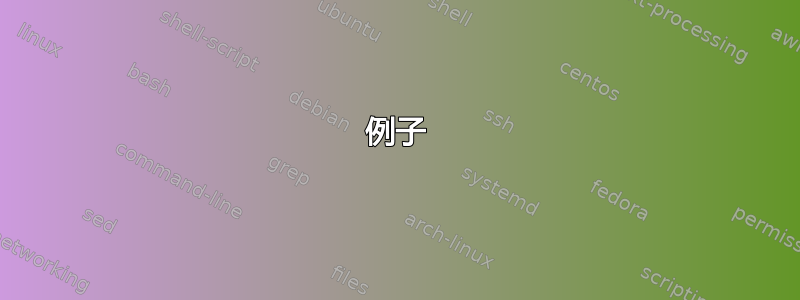
\SetKwFunction{Func}{func}如果我像algorithm2e 中那样定义一个函数,\Func{a, b}则打印
函数(a,b)
默认情况下。我怎样才能让它打印
函数[a,b]
就像在 Wolfram 或
函数 ab
就像 Haskell 一样?
我查看了 algorithm2e 的文档,没有找到任何相关内容,但无法更改这一点似乎是一个奇怪的限制,因为 algorithm2e 中提供了所有自定义功能。如果不可能,有哪些简单的替代方案具有\SetKwFunction类似的行为和能力?
例子
该文件的序言如下:
\documentclass{article}
\usepackage[vlined]{algorithm2e}
\SetFuncSty{textsf}
\SetKwProg{Fn}{function}{}{}
第一种情况由以下代码产生,其他情况展示了它应该如何呈现,但是通过变通方法产生。
\begin{algorithm}[H]
\SetKwFunction{Factorial}{factorial}
\Fn{\Factorial{x}}{
\uIf{\(x \le 1\)}{
0
}\Else{
\(x \cdot \Factorial{\(x-1\)}\)
} }
\end{algorithm}
This here \Factorial{x} grows very rapidly with \(x\).
最后一种factorial x - 1情况下应该有括号,但是我注意到这个错误太晚了,并决定为了演示而保留它。
答案1
我建议对这个包进行一些修改。左括号和右括号是固定的,所以我们用宏来代替它们。此外,还为分隔符指定了单独的样式。
\documentclass{article}
\usepackage[vlined]{algorithm2e}
\makeatletter
\renewcommand{\SetKwFunction}[2]{%
\expandafter\gdef\csname @#1\endcsname##1{%
\FuncSty{#2}\FuncDelSty{\FuncOpen}\FuncArgSty{##1}\FuncDelSty{\FuncClose}%
}%
\expandafter\gdef\csname#1\endcsname{%
\@ifnextchar\bgroup{\csname @#1\endcsname}{\FuncSty{#2}\xspace}%
}%
}
\newcommand{\FuncDelSty}[1]{\textnormal{#1}\unskip}
\newcommand{\SetFuncDelSty}[1]{%
\renewcommand{\FuncDelSty}[1]{\textnormal{\csname#1\endcsname{##1}}\unskip}%
}
\providecommand{\gobblearg}[1]{}
\newcommand{\FuncOpen}{(}
\newcommand{\FuncClose}{)}
\newcommand{\matharg}[1]{\ensuremath{#1}}
\SetFuncArgSty{matharg} % function arguments are in math, not in text
\makeatother
\SetFuncSty{textsf}
\SetKwProg{Fn}{function}{}{}
\ExplSyntaxOn
\NewDocumentCommand{\haskellargs}{m}
{
\seq_set_from_clist:Nn \l_tmpa_seq { #1 }
\ensuremath{\;\seq_use:Nn \l_tmpa_seq { \; }}
}
\ExplSyntaxOff
\begin{document}
\section*{Standard}
\begin{algorithm}[H]
\SetKwFunction{Factorial}{factorial}
\Fn{\Factorial{x}}{
\uIf{\(x \le 1\)}{
0
}\Else{
\(x \cdot \Factorial{x-1}\)
} }
\end{algorithm}
\section*{Brackets}
\begin{algorithm}[H]
\SetKwFunction{Factorial}{factorial}
\renewcommand{\FuncOpen}{[}\renewcommand{\FuncClose}{]}
\Fn{\Factorial{x}}{
\uIf{\(x \le 1\)}{
0
}\Else{
\(x \cdot \Factorial{x-1}\)
} }
\end{algorithm}
\section*{Haskell}
\begin{algorithm}[H]
\SetKwFunction{Factorial}{factorial}
\SetFuncArgSty{haskellargs}
\renewcommand{\FuncOpen}{}\renewcommand{\FuncClose}{}
\Fn{\Factorial{x}}{
\uIf{\(x \le 1\)}{
0
}\Else{
\(x \cdot \Factorial{(x-1)}\)
} }
\end{algorithm}
\begin{algorithm}[H]
\SetKwFunction{Test}{test}
\SetFuncArgSty{haskellargs}
\renewcommand{\FuncOpen}{}\renewcommand{\FuncClose}{}
\Fn{\Test{x,y}}{
\uIf{\(x>y\)}{
$x-y$
}\Else{
$y-x$
} }
\end{algorithm}
\end{document}
当然,你会一劳永逸地选择风格。
答案2
这可以通过SetKwFunction如下改变实施方式来实现:
\documentclass{article}
\usepackage{algorithm2e}
\makeatletter
\renewcommand{\SetKwFunction}[2]{%
\expandafter\gdef\csname @#1\endcsname##1{\FuncSty{#2[}\FuncArgSty{##1}\FuncSty{]}}%
\expandafter\gdef\csname#1\endcsname{%
\@ifnextchar\bgroup{\csname @#1\endcsname}{\FuncSty{#2}\xspace}}%
}%
\makeatother
\begin{document}
\begin{algorithm}
\SetKwFunction{Func}{func}
\SetKwProg{Fn}{Function}{:}{\KwRet}
\Fn{\Func{$f$, $a$, $b$, $\varepsilon$}}{
a\;
b\;
}
\end{algorithm}
\end{document}





